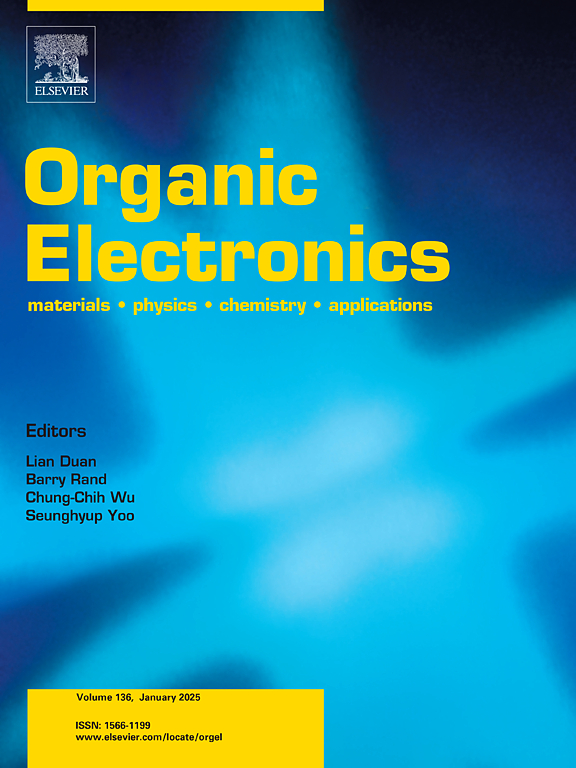Design of non-Aufbau organic radicals based on TTM/TTBrM core
IF 2.6
4区 工程技术
Q3 MATERIALS SCIENCE, MULTIDISCIPLINARY
引用次数: 0
Abstract
Non-Aufbau organic radicals with SOMO-HOMO inversion (SHI) have been attracting significant interest from both theoretical and experimental perspectives. The unusual orbital ordering in these systems makes their electronic properties apart from the more common case, where the unpaired electron is filled in the SOMO which is higher in energy than HOMO. In this work, we designed a series of radical systems based on well-known TTM/TTBrM core, functionalized by various electron donor groups (PDMAC, PPTA, PPXZ, BFCz, PA and PT) to achieve SHI-type radicals. Using density functional theory, it was demonstrated that these electron donor groups can modulate the order of SOMO and HOMO, and all radical systems follow the general illustration of SHI that the α-HOMO pair of matching spin orbitals is higher in energy than the SOMO, and is below the corresponding SUMO in non-Aufbau electronic structures. Moreover, all radical systems exhibit fluorescence radiative rate (kr) approaching approximately 107 s−1. Ab Initio Molecular Dynamics (AIMD) simulation further indicates that all radical systems are stable at high temperatures. Our calculated results show that the formation of SHI-type radical systems is related to the nature of electron donor units. Consequently, PDMAC, PPTA, PPXZ, BFCz, PA, and PT are reliable choices for designing SHI-type radical emitters. Our work thus establishes molecular guidelines for designing SHI-type radical systems and expands their applicability to organic light-emitting diode emitters.

基于TTM/TTBrM核心的非aufbau有机自由基设计
具有SOMO-HOMO反转的非活性有机自由基(SHI)在理论和实验方面都引起了人们极大的兴趣。这些系统中不寻常的轨道顺序使它们的电子性质与更常见的情况不同,在这种情况下,未配对的电子填充在比HOMO能量更高的SOMO中。在这项工作中,我们设计了一系列基于TTM/TTBrM核心的自由基体系,通过各种电子给基(PDMAC, PPTA, PPXZ, BFCz, PA和PT)进行功能化,以获得shi型自由基。利用密度泛函数理论,证明了这些电子给体基团可以调节SOMO和HOMO的顺序,并且所有自由基体系都遵循SHI的一般说明,即匹配自旋轨道的α-HOMO对能量高于SOMO,而在非aufbau电子结构中低于相应的SUMO。此外,所有自由基体系的荧光辐射率(kr)都接近107 s−1。从头算分子动力学(AIMD)模拟进一步表明,所有自由基体系在高温下都是稳定的。计算结果表明,shi型自由基体系的形成与电子给体单位的性质有关。因此,PDMAC、PPTA、PPXZ、BFCz、PA和PT是设计shi型自由基发射器的可靠选择。因此,我们的工作为设计shi型自由基系统建立了分子指南,并扩大了它们在有机发光二极管发射器中的适用性。
本文章由计算机程序翻译,如有差异,请以英文原文为准。
求助全文
约1分钟内获得全文
求助全文
来源期刊

Organic Electronics
工程技术-材料科学:综合
CiteScore
6.60
自引率
6.20%
发文量
238
审稿时长
44 days
期刊介绍:
Organic Electronics is a journal whose primary interdisciplinary focus is on materials and phenomena related to organic devices such as light emitting diodes, thin film transistors, photovoltaic cells, sensors, memories, etc.
Papers suitable for publication in this journal cover such topics as photoconductive and electronic properties of organic materials, thin film structures and characterization in the context of organic devices, charge and exciton transport, organic electronic and optoelectronic devices.
 求助内容:
求助内容: 应助结果提醒方式:
应助结果提醒方式:


